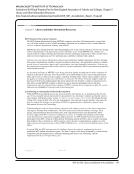SPEC Kit 330: Library Contribution to Accreditation · 107
Brigham Young University
Northwest Commission on Colleges and Universities (NWCCU). Library and Information Resources 5
One area that enjoys endowment funding is the L. Tom Perry Special Collections library, an
unusually robust collection in a wide variety of subject areas.
The libraries’ digital reformatting program is another strength which has developed as a
result of funding from generous donors.
The Lee Library takes pride in its contributions to national authorities databases and its high-
level cataloging, which consistently complies with international standards for bibliographic
description.
Challenges and Recommendations
The libraries have set several strategic goals for the continued strengthening of collections.
Rewrite all collection development policies and make them available to faculty through the
library’s Web site
Designate 2 percent of the collection budget to expand journal and electronic database
collections in response to faculty and student requests and based on documented usage data.
Continue to participate in national and international efforts to develop new modes of
scholarly communication, including collaboration with the Office of Information Technology
in refining the institutional repository model currently in place at the university.
Continue to expand digital reformatting programs, placing new emphasis on audio and video
formats that can be electronically streamed to classrooms, accessed through the online
course-management system, and embedded in online courses.
Determine the appropriate balance between traditional cataloging and metadata functions
related to digital resources. Achieving this goal will become particularly important as the
libraries and the Office of Information Technology implement the institutional repository and
expand digital library collections.
5.C Facilities and Access
DESCRIPTION AND ANALYSIS
Between 1994 and 1999 both the Hunter and Lee library buildings were renovated with
additional collection and study space, adding a total of 285,000 square feet. Today, the Lee
Library has approximately 665,000 sq. ft. and the Hunter Library nearly 97,000 sq. ft. These
large buildings reflect the university policy favoring centralized rather than branch library
services. Student and faculty satisfaction with library facilities is evident in their consistently
high use. It is also reflected in results of the 2004 LibQUAL+ survey, where user perception of
“Library as Place,” the facility and its overall ambience, was near the desired expectation for
both libraries. (See figure 5.3.) According to the survey, students and faculty perceive library
facilities to be comfortable, inviting, and conducive to study, research, and learning.
The libraries continually aim to maximize availability of their books and journals through
a highly efficient shelving operation. Shelvers focus on returning items as rapidly as possible
after they are used. The ambitious standard to shelve all materials within 24 hours is consistently
met or bettered throughout the year, even during the busiest weeks near the end of each semester.
The Lee Library’s extensive book repair program ensures future availability by repairing and
preserving damaged materials. The library operates two repair labs, one dedicated to general
Brigham Young University
Northwest Commission on Colleges and Universities (NWCCU). Library and Information Resources 5
One area that enjoys endowment funding is the L. Tom Perry Special Collections library, an
unusually robust collection in a wide variety of subject areas.
The libraries’ digital reformatting program is another strength which has developed as a
result of funding from generous donors.
The Lee Library takes pride in its contributions to national authorities databases and its high-
level cataloging, which consistently complies with international standards for bibliographic
description.
Challenges and Recommendations
The libraries have set several strategic goals for the continued strengthening of collections.
Rewrite all collection development policies and make them available to faculty through the
library’s Web site
Designate 2 percent of the collection budget to expand journal and electronic database
collections in response to faculty and student requests and based on documented usage data.
Continue to participate in national and international efforts to develop new modes of
scholarly communication, including collaboration with the Office of Information Technology
in refining the institutional repository model currently in place at the university.
Continue to expand digital reformatting programs, placing new emphasis on audio and video
formats that can be electronically streamed to classrooms, accessed through the online
course-management system, and embedded in online courses.
Determine the appropriate balance between traditional cataloging and metadata functions
related to digital resources. Achieving this goal will become particularly important as the
libraries and the Office of Information Technology implement the institutional repository and
expand digital library collections.
5.C Facilities and Access
DESCRIPTION AND ANALYSIS
Between 1994 and 1999 both the Hunter and Lee library buildings were renovated with
additional collection and study space, adding a total of 285,000 square feet. Today, the Lee
Library has approximately 665,000 sq. ft. and the Hunter Library nearly 97,000 sq. ft. These
large buildings reflect the university policy favoring centralized rather than branch library
services. Student and faculty satisfaction with library facilities is evident in their consistently
high use. It is also reflected in results of the 2004 LibQUAL+ survey, where user perception of
“Library as Place,” the facility and its overall ambience, was near the desired expectation for
both libraries. (See figure 5.3.) According to the survey, students and faculty perceive library
facilities to be comfortable, inviting, and conducive to study, research, and learning.
The libraries continually aim to maximize availability of their books and journals through
a highly efficient shelving operation. Shelvers focus on returning items as rapidly as possible
after they are used. The ambitious standard to shelve all materials within 24 hours is consistently
met or bettered throughout the year, even during the busiest weeks near the end of each semester.
The Lee Library’s extensive book repair program ensures future availability by repairing and
preserving damaged materials. The library operates two repair labs, one dedicated to general
























































































































































































